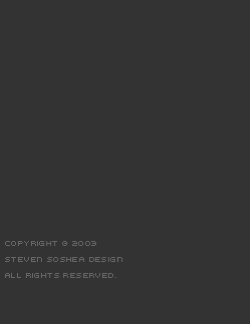
 |
A Definition In nature, every organism (plant, animal, etc.) has a native environment from which that organism has evolved. While some organisms are more adaptive to various environments than others, all organisms have specific environmental conditions that are optimally suited for them. Similarly, every designer has a creative environment that is best suited for them. This optimal landscape caters to a designer's specific strengths and abilities, providing opportunities for nurturance and growth that other environments cannot give. As designers, we can therefore define the process of personal and professional development as the quest to find and establish ourselves within our specifically native creative environment. In this manner, we are true to ourselves. Each of us exists within our own contextually appropriate creative space. Once rooted within this environment, our creative activities will grow forth from a sense of place or connectedness. From this sense of place, We are aptly suited to evolve and grow to the natural extent of our abilities and opportunities. Resisting Monoculture Design Just as the health of an environment can be seen in the variety of symbiotic life forms, so too can the health of a creative environment be seen in the variety of its expression. While there are competitive dynamics that promote individual theoretical or aesthetic "life forms" across a given creative landscape, that environment is much more vibrant, healthy, and sustainable when the symbiotic relationships of diversity are maintained. In other words, each creative expression fills an appropriate niche within a given environment. A "monoculture" orientation to design voids any possibility of naturally dynamic interaction and therefore becomes unsustainable and weak when broadly applied across a given creative endeavor. By valuing individual expression, our creative environments are naturally robust, with each expression occupying its appropriate place within the greater scheme of things. Understanding Differences By understanding patterns of similarities and differences between creative expressions, we gain insights into the wisdom of perspectives that differ from our own. Creative orientations initially considered dissimilar may reveal similarities when examined in detail. Conversely, analyzing similar approaches may reveal conflicting internal structures or motivations. This deeper understanding of the design process enables us to create richer expressions of our individual creative vision. Relevance to Brand and Identity Within commercial practice, having a clearer sense of place as a designer allows for a more comprehensive understanding and articulation of a client's brand. Being grounded in our understanding of self, we are better able to observe, understand, promote our interpretations of the cultural connections that are central components to company projects, rather than simply mimicking current fads or promoting more personal agendas. In other words, by knowing ourselves we are more able to observe and interpret inherent characteristics in others and the organizations they represent, rather than falsely project attributes that we only wish to see as a by-product of self-projection. Pathways through Media and Technology As media and the technologies that surround them evolve and grow, we are constantly challenged to grow in step with them. If we are secure within ourself, we are better able to ride with the waves of technological advancement in a manner that advances our core competencies. But without a strong sense of self or place, we are left to drift between technologies, grasping for things we are told we need rather than holding those that are inherently within our reach. |
 |